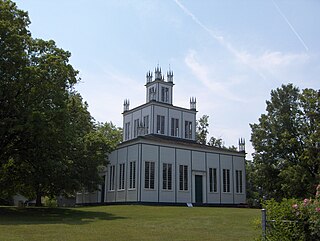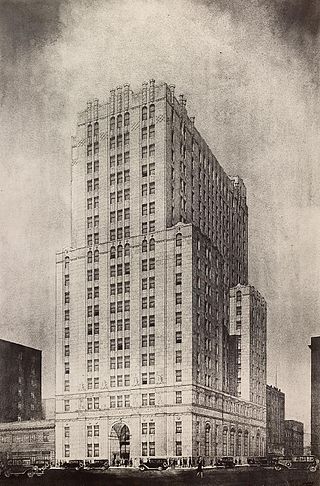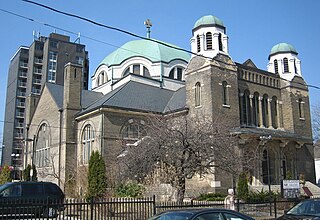
The Sharon Temple is an open-air museum site, located in the village of Sharon, Ontario, that was in 1990 designated as a National Historic Site of Canada. It is composed of eight heritage buildings and dwellings, and houses 6,000 artifacts on a 1.8 ha. site. The building is made available for public use such as tours, concerts, weddings, and special occasions by its current owner, the Sharon Temple Museum Society.

The Distillery District is a commercial and residential district in Toronto, Ontario, Canada, east of downtown, which contains numerous cafés, restaurants, and shops housed within heritage buildings of the former Gooderham and Worts Distillery. The 13 acres (5.3 ha) district comprises more than forty heritage buildings and ten streets, and is the largest collection of Victorian-era industrial architecture in North America.

The Ontario Heritage Trust is a non-profit agency of the Ontario Ministry of Tourism and Culture. It is responsible for protecting, preserving and promoting the built, natural and cultural heritage of Canada's most populous province, Ontario.

The Royal Bank Building refers to two office buildings constructed for the Royal Bank of Canada in Toronto financial district in Ontario, Canada:

The Carlu is an historic event space in Toronto, Ontario, Canada. Opened in 1930 and known as the eponymous "Eaton's Seventh Floor", the venue was restored and reopened in 2003, renamed for its original architect. The Carlu is one of Toronto's best examples of Art Moderne architecture. The venue is owned by restaurant firm Oliver & Bonacini.

The Canada Permanent Trust Building is an 18-storey office building located at 320 Bay Street, in downtown Toronto. It was designed by the architect Henry Sproatt and completed in 1930.

205 Yonge Street was formerly a four-story Bank of Toronto building built in 1905 in Toronto, Ontario, Canada. It was designated under the Ontario Heritage Act in 1975. The E. J. Lennox-designed structure has a domed roof and Corinthian columns on the front, and it is an example of neoclassical architecture.

The Toronto Street Post Office, also known as Toronto's Seventh Post Office, is a heritage building in Toronto, Ontario, Canada. It was completed in 1853 and is located at 10 Toronto Street in downtown Toronto. The building was designed by Frederick William Cumberland and Thomas Ridout in the Greek Revival style.

Toronto's First Post Office is a historic post office in Toronto, Ontario. It is the oldest purpose-built post office in Canada that functioned as a department of the British Royal Mail, and the only surviving example. After its initial use as a post office, it became part of a Roman Catholic boys' school and later a cold storage building. Located at 260 Adelaide Street East in downtown Toronto, the building now houses a museum and a full-service post office, run by the Town of York Historical Society.

The Bank of Upper Canada Building is a former bank building in Toronto, Ontario, Canada, and one of the few remaining buildings in Toronto that predate the 1834 incorporation of the city. It is located at 252 Adelaide Street East, in the Old Town district. Opened in 1827, in what was then the town of York, the building housed the Bank of Upper Canada until the bank's collapse in 1866. It was then used for school purposes and later for various commercial and industrial purposes before being restored in 1982 as commercial office space. The building has been designated a National Historic Site of Canada since 1977.

George Brown House is a historic building in the Grange Park neighbourhood of Toronto, Ontario, Canada. It was home to Father of Confederation, Reform Party politician and publisher George Brown. Its current address is 186 Beverley Street.

The Dominion Public Building is a five-storey Beaux-Arts neoclassical office building built between 1926 and 1935 for the government of Canada at southeast corner of Front and Bay streets in Toronto, Ontario, Canada.
Willowbank is a mansion in Queenston, Ontario, Canada.

Walnut Hall was a row of four Georgian-style terraced homes in Toronto, Ontario, Canada. Constructed in 1856, it was recognized by both the Government of Canada and the City of Toronto as being of historic significance, but portions of it collapsed and it had to be demolished in 2007 due to neglect. At the time of its demolition, it was Toronto's last remaining complete row of 19th century Georgian townhomes.

St. Anne's Anglican Church is a historic Anglican parish church located in the Brockton Village neighbourhood of Toronto, Ontario.

The National Hotel was a hotel built on the southeast corner of King and Sherbourne streets, in Toronto, Ontario, Canada. Under pressure for condominium apartment redevelopment, the City of Toronto attempted to preserve the building, designating it a heritage site in 2009, but the building was eventually torn down in 2013. The hotel's north and west facades were preserved as part of the new condominium development, examples of "facadism" in Toronto.

The Dixon Building and Griffiths Building are parts of a heritage building located on Front Street, Toronto, Ontario. The 3+1⁄2-storey building is an example of Second Empire architecture and was constructed in 1872-3 according to the designs of Walter Strickland.

The Union Building is an older building in Toronto that has been described as an "architectural gem". When it was built, in 1908, on the Northwest corner of King and Simcoe streets, it was directly across from the palatial official residence of the Lieutenant Governor of Ontario.
The CIL Building is a fourteen-storey office tower located at 130 Bloor Street West in Toronto, Ontario. Designed by the architectural firm Bregman and Hamann and completed in 1960, the building is one of Toronto's best examples of International Style architecture. The CIL building is best known for its two-storey penthouse, which was originally occupied by businessman Noah Torno and is now a designated historic property.


















